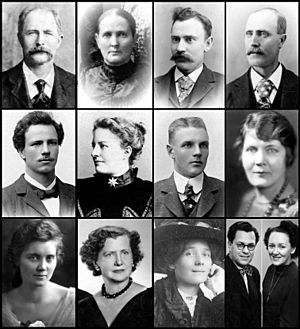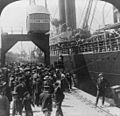Swedish emigration to the United States facts for kids

During the Swedish emigration to the United States in the 19th and early 20th centuries, about 1.3 million Swedes left Sweden for the United States of America. While the land of the U.S. frontier was a magnet for the rural poor all over Europe, some factors encouraged Swedish emigration in particular. The religious repression practiced by the Swedish Lutheran State Church was widely resented, as was the social conservatism and class snobbery of the Swedish monarchy. Population growth and crop failures made conditions in the Swedish countryside increasingly bleak. By contrast, reports from early Swedish emigrants painted the American Midwest as an earthly paradise.
According to Joy K. Lintelman, mass migration from Sweden to the United States unfolded in five distinct waves between the 1840s and 1920s. Within this period, hundreds of thousands of Swedish emigrants made their way over and settled in both rural and urban scapes of the United States. Factors which brought migration to a trickle were found on both sides of the Atlantic, with restrictions on immigration placed in the United States and improving social and economic conditions in Sweden being the primary factors.
Swedish migration to the United States peaked in the decades after the American Civil War (1861–1865). By 1890 the U.S. census reported a Swedish-American population of nearly 800,000. These rising emigration rates caused great concern in Sweden. However, before any reform could be done to avoid a continuous flow of Swedish citizens fleeing the home land, World War I (1914–1918) broke out and effectively concluded almost any movement. From the mid-1920s, there was no longer a Swedish mass emigration.
Memory
The best-known artistic representation of the Swedish mass migration is the epic four-novel suite The Emigrants (1949–1959) by Vilhelm Moberg (1898–1973). Portraying the lives of an emigrant family through several generations, the novels have sold nearly two million copies in Sweden and have been translated into more than twenty languages. The tetralogy has been filmed by Jan Troell as The Emigrants (1971) and The New Land (1972), and forms the basis of Kristina from Duvemåla, a 1995 musical by former ABBA members Benny Andersson and Björn Ulvaeus.
In Sweden, the Småland city of Växjö is home to the Swedish Emigrant Institute (Svenska Emigrantinstitutet), founded in 1965 "to preserve records, interviews, and memorabilia relating to the period of major Swedish emigration between 1846 and 1930". The House of the Emigrants (Emigranternas Hus) was founded in Gothenburg, the main port for Swedish emigrants, in 2004. The centre shows exhibitions on migration and has a research hall for genealogy. In the U.S., there are hundreds of active Swedish-American organizations as of 2007[update], for which the Swedish Council of America functions as an umbrella group. There are Swedish-American museums in Philadelphia, Chicago, Minneapolis, and Seattle. Rural cemeteries such as the Moline Swedish Lutheran Cemetery in central Texas also serve as a valuable record of the first Swedish people to come to the United States.
Images for kids
-
In the Land of Promise, Castle Garden, 1884, by Charles Frederic Ulrich, showing the Emigrant Landing Depot in Manhattan.
-
Swedish emigrants boarding ship in Gothenburg in 1905.
-
Distribution of Swedish Americans in 2000 by county, according to the United States Census.
See also
 In Spanish: Inmigración sueca en los Estados Unidos para niños
In Spanish: Inmigración sueca en los Estados Unidos para niños








